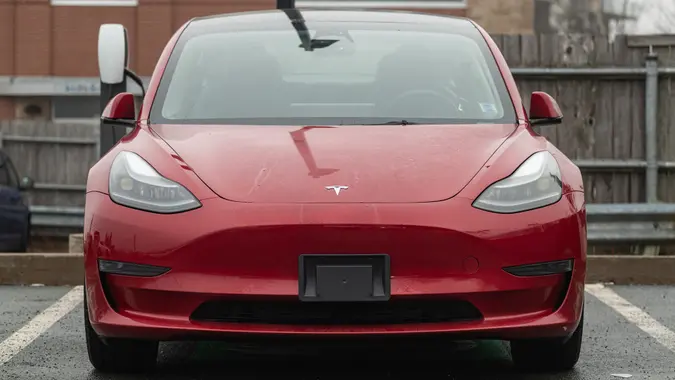5 Cars Boomers Won’t Be Able To Afford in Less Than a Decade

Commitment to Our Readers
GOBankingRates' editorial team is committed to bringing you unbiased reviews and information. We use data-driven methodologies to evaluate financial products and services - our reviews and ratings are not influenced by advertisers. You can read more about our editorial guidelines and our products and services review methodology.

20 Years
Helping You Live Richer

Reviewed
by Experts

Trusted by
Millions of Readers
Retirees relying solely on Social Security often have a tighter budget, and buying things like a new car can be out of reach. According to a recent report by Edmunds, the average cost of a new car is $47,542, and for people living paycheck to paycheck, that’s not feasible. So, how much should you spend on a new car? There’s no exact number, but there is a rule to follow.
“Your monthly expenses should not exceed 36% of your gross income,” said Eric Mangold, CWS founder of Argosy Wealth Management. “If you were to add up all your recurring expenses, like your mortgage, taxes, insurance, other debt payments, student loans, car loans, etc., and then divide it by your gross income, if it is more than 36%, you may feel a bite in your lifestyle.”
While a shiny new car might be tempting, it also might not be the best financial decision — especially if you choose a vehicle that’s going to need expensive repairs within the next decade, not to mention insurance costs with premiums ever-increasing. For boomers on a budget, avoid these new cars if you don’t want to break the bank.
Jeep Grand Cherokee Overland
- Starting at $60,995
The Jeep Grand Cherokee Overland is a stylish and comfortable ride, but it’s not just the expensive price tag that is something to watch out for.
“Annual insurance can hover around $1,400-$2,300 due to its off-road features and higher theft rates,” explained Rob Dillan, automotive expert and founder of EVhype. “Common repair costs — like air suspension fixes — can exceed $1,500 each. Full-size SUVs with sophisticated 4×4 systems trend higher than average in repair frequency after 5 plus years.”
BMW 3 Series M340i
- Starting at $60,200
Known for its sporty design and luxury feel, the BMW 3 Series M340i is an ideal balance of power and technology, but Dillan warned boomers to stay away.
“Expect monthly premiums of $200-$250,” he said. “Out-of-warranty brake jobs can run $1,500, and replacing high-end tech features — like sensors or iDrive components — might approach $1,000 per fix.”
He added, “While BMW ranks well in initial quality, costs spike after 50,000 miles. Owners frequently cite issues with infotainment and turbochargers, which can wreak havoc on a retiree’s budget.”
Audi Q5 Premium Plus
- Starting at $45,300
With their sleek look, cutting-edge tech gadgets and powerful performance, Audi remains a symbol of luxury and quality. While Audis are beautifully designed and packed with cool features, they get pricier over time.
“Audi owners can pay up to $3,500 annually for insurance, partly because of pricier parts and advanced electronics,” Dillan said. “Brake and suspension jobs can regularly top $1,000 each. The Q5 scores decently for its first few years, but turbo and transmission repairs become more common beyond 60,000 miles — costs can spike just as that factory warranty expires.”
Genesis G80
- Starting at $57,100
With its chic look and luxurious feel, the Genesis G80 is an attractive choice for car buyers, but the sticker price isn’t the only shocking expense.
“Luxury sedans like the G80 can see annual insurance rates of around $3,700,” Dillan said. “Although Hyundai/Kia parts aren’t as expensive as German brands, the G80’s sophisticated features — like adaptive cruise control — can be pricey to fix, too.”
He added, “Despite a strong warranty, some owners report issues with steering vibration and infotainment software. Once the bumper-to-bumper coverage lapses, these premium systems can become costly headaches.”
Volvo XC60 Recharge Plug-in Hybrid
- Starting at $58,050
Plug-in hybrid electric vehicles (PHEVs) could be a great option for those who worry about the hassle of stopping to charge, because they run on electric power for shorter distances but have the ability to switch to gas for longer trips. However, maintenance and other costs can make a PHEV unaffordable.
“PHEVs typically add around 7% per year to insurance vs. their gas-only counterparts, as specialized battery components and electric motors have higher repair or replacement costs,” Dillan explained.
“Owners often enjoy the quiet, smooth ride early on,” he added. “However, battery and software issues reported for years four or five can result in $1,000 plus repair bills. For fixed-income retirees, those sudden large expenses aren’t easy to absorb.”
Expensive cars clash with the reality of a fixed income, and when factoring in other costs, such as insurance rates and maintenance fees, many cars are unattainable for retirement budgets.
“From my experience running EVhype.com, I can tell you that many future-ready vehicles come with big bills, and balancing excitement with financial security remains the biggest challenge,” Dillan said.
 Written by
Written by  Edited by
Edited by 

























